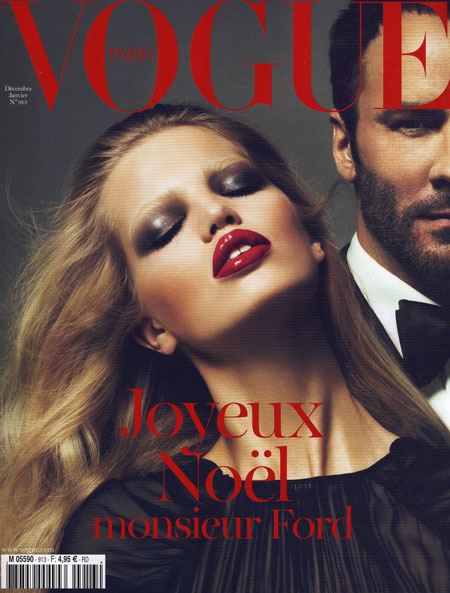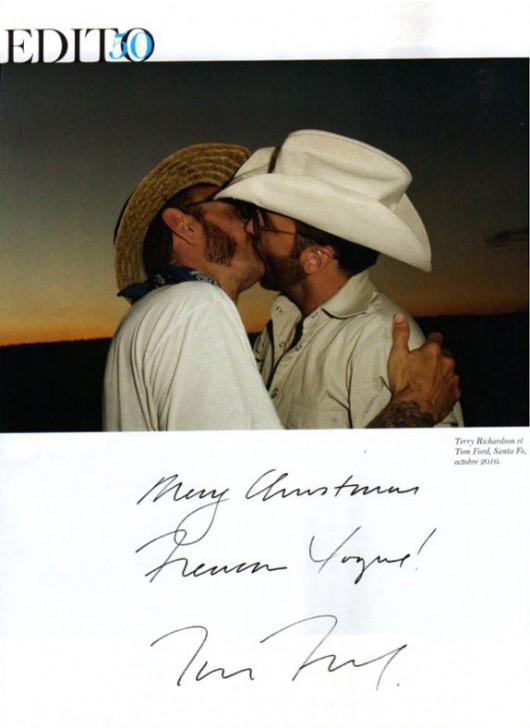Since the now legendary fashion biz earthquake, caused by Carine Roitfeld’s VOGUE Paris exit, the speculations about her future moves are running rampant. Did she leave to join Tom Ford in his new venture, or for licensing products with her own name (like Anna Della Russo’s Perfume)? Or was she simply fired by Jonathan Newhouse, the Chairman of Conde Nast International? Do we really want to know the reasons?
What is interesting here is the position that it has put the luxury press in, as it relates to VOGUE Paris.
The market has evolved and the relation between advertisers and publishers is more than ever, inseparable. Luxury press lives by one thing only: advertising. It is not a revelation to say that advertisers are expecting a ROI (return on investment) when they spend millions on pages of advertising in a magazine. They monitor the feedback in magazines to make sure that the visibility in editorials match their advertising expenditure. During the last decade, several elements have reinforced the demands of the advertisers: to compensate for the loss of market share in the West, especially since the world-wide financial crisis and the drop in audience of the historically recognized fashion magazines.
Advertisers want to be make sure they are seen by a large and qualitative audience (high income population). The consequence of a decrease in audience is a trade off of the advertising budget to cater to where the audience resides. More and more, the Internet is the media that offers a qualitative and very well defined audience with a transparent ROI. The Publishers, for much too long, considered Internet a gadget or a hobby for weekend fashion bloggers. They neglected the net and are now trying to get back on track with a replication of the print version of their magazines. What is interesting, is that some of the major fashion blogs have a larger audience than some of the VOGUE Internet sites. 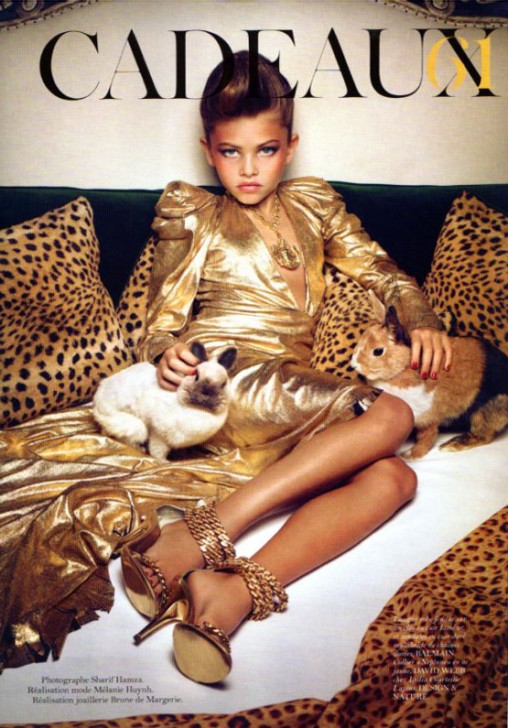 They are having to clean up shop and adopt newer modes of getting their message out to the public at large. It comes to a point where magazines like VOGUE are happily sharing their fashion content with the big blogs to make sure that they get more visibility. Interestingly, those big blogs are getting free content from credible publishers and getting advertising revenues because they have an established audience. Will these blogs be in a position to buy out VOGUE in the not so distant future???
They are having to clean up shop and adopt newer modes of getting their message out to the public at large. It comes to a point where magazines like VOGUE are happily sharing their fashion content with the big blogs to make sure that they get more visibility. Interestingly, those big blogs are getting free content from credible publishers and getting advertising revenues because they have an established audience. Will these blogs be in a position to buy out VOGUE in the not so distant future???
10 years ago, Carine was hired because of the direction she successfully established when she worked with Tom Ford: she used highly sexually charged and controversial imagery to revamp VOGUE Paris from its humdrum homogenized earlier carnation. Carine reached her goal in establishing her own style and vision, to make VOGUE Paris one the most viewed fashion books in the industry. But what became a commercial success with Tom did not achieve the same result in terms of sales of the magazine. A controversial and edgy direction does not always lead to commercial success.
 For instance, VOGUE Italia that is considered by many as the most creative of all the editions of VOGUE in the world is not a best seller. Far from it. Because of its small circulation, it is considered a professional user magazine by advertisers in Italy. Franca Sozzani is talking about her job at VOGUE Italia.
For instance, VOGUE Italia that is considered by many as the most creative of all the editions of VOGUE in the world is not a best seller. Far from it. Because of its small circulation, it is considered a professional user magazine by advertisers in Italy. Franca Sozzani is talking about her job at VOGUE Italia.
Yes, the Editor-in-Chief is a political job that navigates between meeting the needs of the advertisers and setting the direction of fashion trends. Loosing the balance is the beginning of the end.
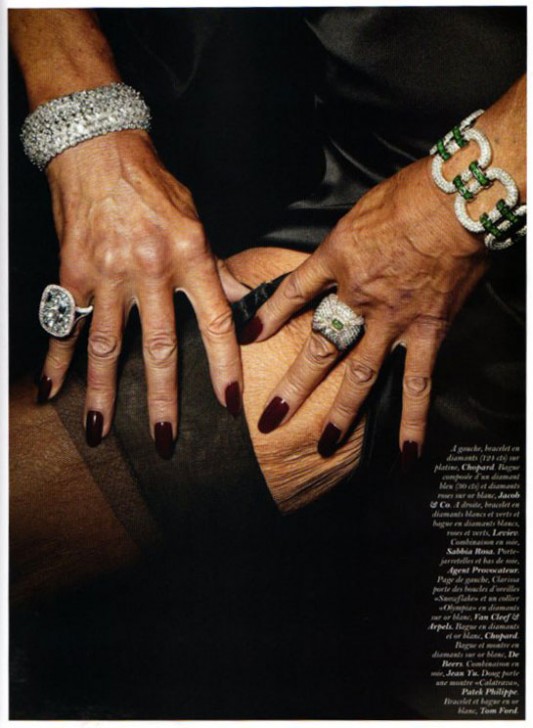 Even though I was never a fan of her porno-chic trend, Carine was most certainly a very good photo stylist who had a defined fashion direction (whether you like it or not). If she was asked to leave VOGUE Paris, or left on her own free will, what I am sure of, is that the last issue of VOGUE Paris – December/January 2011 issue feels like she intentionally made the choice that it be her last stand and to make it her most controversial issue ever.
Even though I was never a fan of her porno-chic trend, Carine was most certainly a very good photo stylist who had a defined fashion direction (whether you like it or not). If she was asked to leave VOGUE Paris, or left on her own free will, what I am sure of, is that the last issue of VOGUE Paris – December/January 2011 issue feels like she intentionally made the choice that it be her last stand and to make it her most controversial issue ever.
In looking at the cover and the introductory editorial content, you would think that they forgot that the magazine is actually intended to be read by the public and not an extremely expensive personal greeting card between friends. And don’t get me going on the Terry Richardson and Tom Ford “having a really good time” image, followed by little girls heavily made up, with lascivious poses closer to pedophilia, than girls playing disguise in their mums’ outfits.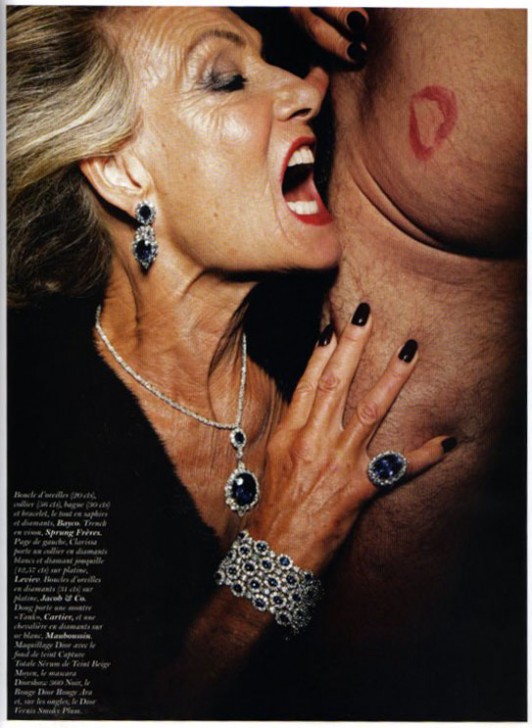
Reading more closely, you find a not so indulgent portrait of Tom Ford by Nelly Kaprièlan who described him as a narcissistic control freak manipulator, but who is none the less, trying to get over it. Then, you have his 12 year-old niece, Miranda Diaz who Tom is trying to transform into a stiletto kid, who seems to be more centered and stable than her uncle.
The Beauty section is interesting. That is, if you ARE NOT between 13 and 70. If you aren’t then skip this issue. You are not part of the target group. Yes, wearing make up at 13 seems to be the norm in this issue. If you are 70 you can use it, but with caution and moderation.
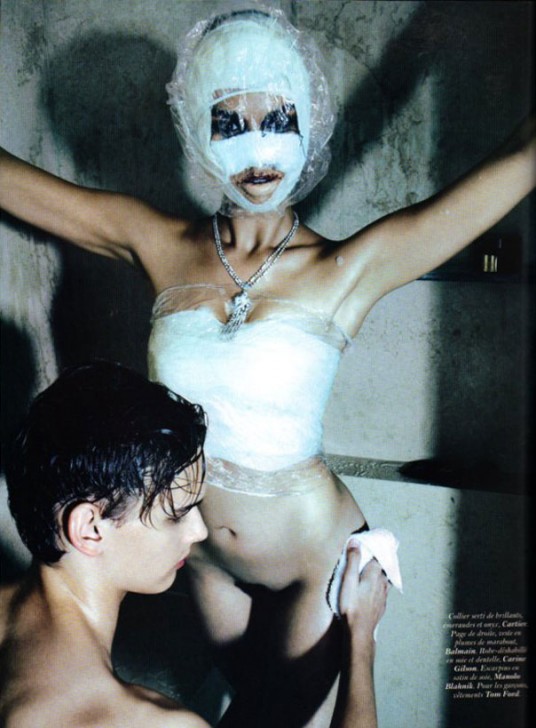 And then of course you have Tom Ford’s Fashion Collection shot by Mert & Marcus, creating that “Oh, so the same pose” on all the models, with their ecstasy driven loosely closed eyes, orgiastic and highly exaggerated open mouths and flayed back, whip lashed heads. A jewelry editorial shot by Tom Ford, showing a crumpled skinned old couple making love. No problem with that, but it is full of contradictions, as Tom Ford praises aging without artifice, but uses Botox himself. Finally the last fashion editorial also shot by Tom Ford: a 10 page story with the now thinner Crystal Renn at least recognizable on the last 2 pages where she is not totally covered in bandages and scares from a horrifically gone bad, fake plastic surgery session.
And then of course you have Tom Ford’s Fashion Collection shot by Mert & Marcus, creating that “Oh, so the same pose” on all the models, with their ecstasy driven loosely closed eyes, orgiastic and highly exaggerated open mouths and flayed back, whip lashed heads. A jewelry editorial shot by Tom Ford, showing a crumpled skinned old couple making love. No problem with that, but it is full of contradictions, as Tom Ford praises aging without artifice, but uses Botox himself. Finally the last fashion editorial also shot by Tom Ford: a 10 page story with the now thinner Crystal Renn at least recognizable on the last 2 pages where she is not totally covered in bandages and scares from a horrifically gone bad, fake plastic surgery session.
Amongst the controversial pages, there is however a remarkable architectural series of Tom Ford’s Ranch in Santa Fe, New Mexico shot by the highly acclaimed photographer Guido Mocafico.
I can understand why the advertisers made a fuss about this last issue that just may have been intended to create the consequences of doing so…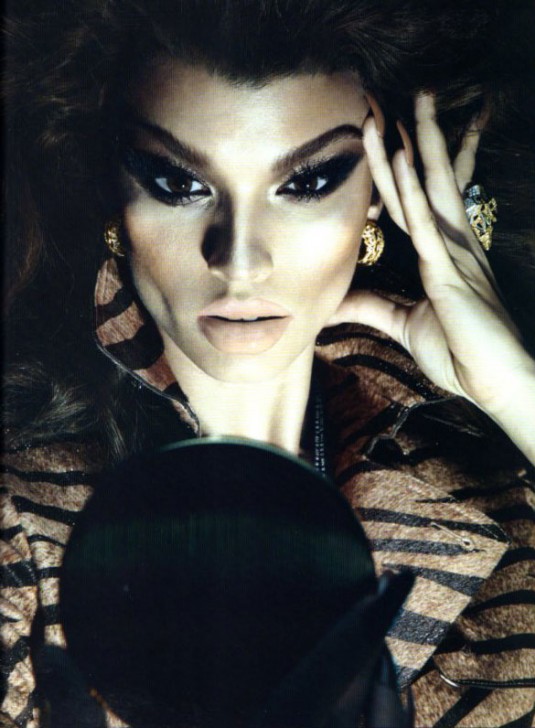
There is one thing for sure, the next VOGUE Paris will be more consensual (as is the case in most of the editions of VOGUE throughout the world) and closer to the public’s taste. I do however hope that the next Editor-In-Chief will have a distinct direction for the magazine, with written content that is given as much attention as the visual aspect of the magazine, but will go beyond the satisfying of the advertisers demands.
After reading Tom Ford’s interview where he spoke at length about his depression and his long slump, I was hoping to see a powerful, expressive, innovative and focused fashion statement. Unfortunately what was experienced in this collection, was the pungent smell of Déjà Vu.
Make up your own mind with the video of the Spring/Summer 2011 collection that was unveiled in front of a few friends, journalists, celebrities and the photographer Terry Richardson.
All pictures from VOGUE Paris Christmas 2010 issue

